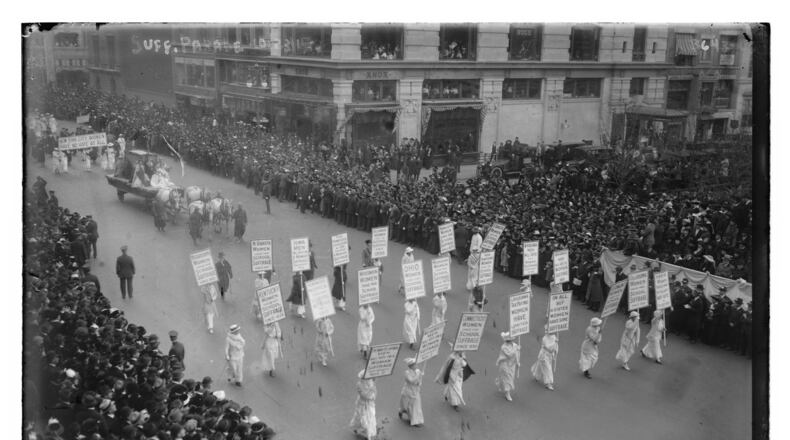Georgia Gov. Brian Kemp recently appointed Kelly Loeffler to the United States Senate to fill the unexpired term of Johnny Isakson. She became the second woman from Georgia — and the first in nearly a century — to serve in that august body. Her appointment comes at an interesting time in our history as it coincides with the centennial of the passage of the 19th Amendment that granted women the right to vote.
As one of the most important events of the 20th century, the 19th Amendment to the U.S. Constitution was passed by both houses of the U.S. Congress in the summer of 1919. One year later, in August 1920, the amendment was ratified by the 36th state — meeting the three-fourths, constitutional requirement needed to become law.
As we look back at the passage of the 19th Amendment during this historic year, it is fitting for us to reflect on the legacy of the struggle for women’s suffrage. To that end, the Georgia Historical Society has chosen the passage of the 19th Amendment, in which women won the right to vote 100 years ago, as the theme of the 2020 Georgia History Festival.
As a former classroom teacher, I have often been frustrated by the constraints of educational standards meant to cram extensive historical content into one or two semesters. State educational standards tend to hit the “highlights” and require teachers to broach each topic, not cracking open the wealth of stories that make history interesting or relevant.
The passage of the 19th Amendment is one of those topics regularly found in school curricula that receives short shrift. The fight for women’s suffrage has been traditionally taught through the experiences of a handful of notable individuals such as Susan B. Anthony and Elizabeth Cady Stanton, overlooking the broader, more-nuanced story that varied from region to region.
Examining the movement within the context of Georgia and the social, cultural, and economic realities of the Jim Crow South presents a unique opportunity to gain a deeper understanding of what really happened as women pushed for full civil rights.
In order to make sense of the complexity of opinions and levels of participation within the women’s suffrage movement in Georgia, we should take into consideration the variety of experiences of the people involved that include underrepresented perspectives such as those of from African-American women, anti-suffrage campaigners, and members of the working-class.
The movement in Georgia took many twists and turns. Both pro- and anti-suffrage groups organized and wielded the power of new media in the 20th century in order to sway public opinion. Though often hailed as a Progressive reform, the movement in Georgia took place during an era of racial tension that spanned the Civil War, Reconstruction, and the advent of Jim Crow and black disenfranchisement.
This is evidenced in a letter found in the Stewart Huston Family Papers located at the Georgia Historical Society from Anna Howard Shaw, president of the National American Woman Suffrage Association, to a Savannah resident and suffragist. Writing in 1913, Shaw makes the point that many whites feared that woman suffrage threatened to unravel the fabric of Southern society by diminishing the power of white supremacy through black enfranchisement.
Shaw’s sentiment underscores efforts at that time to disenfranchise black men. She’s hoping the imperative of white supremacy could be used to support white female suffrage — or that the only way to ensure black disenfranchisement was to empower white women to vote. Through this letter, she reveals the impact of racial politics in Southern society and the limitations of the women’s suffrage movement and its commitment to freedom and equality.
The study of the women’s suffrage movement can only make sense when placed within the ongoing struggles for civil rights throughout the 20th century. The passage of the 19th Amendment was another step, albeit a giant one, in the larger struggle to secure for all Americans, regardless of their race or gender — the right to full participation in our nation’s political process.
For example, the passage of the 19th Amendment — what many hailed as revolutionary — was only a victory for some: It would be another 45 years, with the passage of the Voting Rights Act of 1965 (through the hard work of the Civil Rights Movement), before African American women could finally vote nationwide.
So, the lesson ultimately lies in the struggle — sometimes forceful and sometimes violent — to extend what Abraham Lincoln called “the promise of the Declaration of Independence” to all citizens of our republic. The struggle, after all, is what reminds us that freedoms can be tenuous and universal suffrage only serves to strengthen American democracy.
As one of the most critical battles for civil rights in American history, the women’s suffrage movement set the stage for social justice movements that characterized the United States in the 20th century and that continue to inform Georgia’s politics today. Studying this crucial period in Georgia and American history helps us understand how we got here — a place where, for only the second time in a century, a woman represents Georgia on the Senate floor.
Lisa Landers is the education coordinator, and Dr. Stan Deaton is the Dr. Elaine B. Andrews Distinguished Historian, at the Georgia Historical Society.
About the Author
Keep Reading
The Latest
Featured



